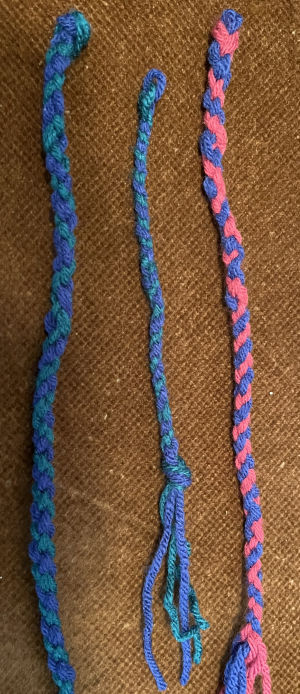The rightmost braid is the one mentioned in the previous post. The leftmost braid is a repeat of the fingerlooping methods. Again, I tried both methods -- move the index finger to the middle finger vs move the ring finger to the middle finger.
They're pretty much identical from a braid structure standpoint -- the index and ring finger on one hand switch clockwise, and the index and ring finger on the other hand switch counterclockwise. With one, the index finger loop goes over the ring finger loop; with the other, the ring finger loop goes over the index finger loop.
Either one can spiral S or Z; it depends on the arrangement of the colors vs how the loops switch. Do I remember which is which? Umm, no. But it was obvious when I'd mess up by switching the twist directions by accident, and then switching back. I got both S and Z spirals with each of the methods.
Too bad the contrast on the left two braids is so low, because they were very informative. Both are in green and blue, with the fatter braid being fingerlooped and the thinner one single-strand freehand braided.
The middle one happened after I poked around on the 'net and my own books and stuff. It's a different method than the other freehand methods I wrote about earlier, though of course they're all kind of the same and it's mostly about the way my brain understands what is going on.
For the middle one -- think of these four elements being arranged in a circle instead of flat. Instead of 1 2 3 4, we have NW SW SE NE. As with fingerlooping and disk braiding, we're going to swap NW and SE in one direction, and then swap NE and SW in the other.
So... cross NW over SE, then cross NE over SW. Twist your wrists and move your fingers (and strands) as appropriate to make sure that the pairs of elements crossing each other don't interfere with the currently-passive elements or vice versa. As with the other braids, the spiral direction (and color pattern in general) depends on the arrangement of the colors vs the direction of the crossing twists. One can, of course, cross under rather than over, but for me, the cross-over twist of my fingers felt more natural than the cross-under.
Here's a paracord video that shows it, though with the color arrangement that leads to vertical stripes rather than a spiral: https://www.youtube.com/watch?v=UtWWA6MQXGE and it can also be seen fairly well on Sally Pointer's video (the second braid, starting about halfway through the video): https://www.youtube.com/watch?v=TwVXwH_w2ng
Am I done? Maybe. I'm probably not going to explore disk/stand braiding or whipcording because the how-to for those is pretty straightforward. I am going to try to pay attention to figure out which color arrangements lead to which spiral direction. It should be pretty obvious pretty quickly.
Whipcording (aka Viking whipcord or interlocking or slinging) -- as far as I know, there's no unambiguous evidence of this method being used before the 17th century. Honestly, though, whipcording just seems to be doing this braid with wooden bobbins to hold the excess length of unbraided yarn, plus hanging it from something high so it can be worked downwards vertically, plus adding a second person if so desired to make it a game (by tossing pairs of bobbins back and forth). It would be useful if making long lengths of cord. But for something that's roughly 8" long, like the Skjoldehamn hood ties? I'm thinking freehand or fingerloop since either can be done pretty spontaneously.
Dunno if and when I'll explore more 4-strand braiding stuff, such as other braid structures. I'm also not going to track the history of these braids, because they tend to be pretty universal over time and space, going way way back. People are clever.
So one possibility for a class is this braid, period. I could do the fingerloop method and only that. Or I could do fingerloop and freehand. Or even fingerloop, freehand, and disk. It would be in the context of the Skjoldehamn hood ties, with a general discussion of this braid throughout history.
If I did a second class, it would be the 6 strand pigtail-type braid used decoratively on the cuffs, necklines, etc., in the Skjoldehamn outfit, both freehand and fingerlooped.
So ends today's ramblings on this particular 4-strand braid structure. Maybe. There might well be an upcoming post on the 6 strand braid and maybe an example of the 4-strand braid showing which color placements lead to which patterns, so my poor little goldfish brain has something to return to later.

No comments:
Post a Comment